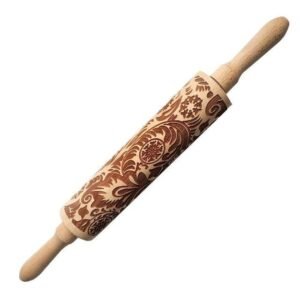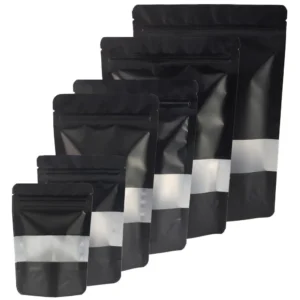Introduction
Peking Duck, the epitome of Chinese culinary excellence. This renowned dish, authentic Peking duck, delights with its crispy skin and succulent meat, making it a true delicacy. Whether you prefer roast duck, chicken, or any other kind of poultry, learning how to cook it properly is essential. Originating from Beijing, China, Peking Duck, a dish made with ducks, is often served with mandarin pancakes, chicken, and spring onion at special occasions and has become a symbol of celebration. The tender duck breast, carefully roasted to perfection, offers a tantalizing experience for food enthusiasts seeking an unforgettable gastronomic adventure. Join us as we dive into the rich history and irresistible flavors of Peking Duck, exploring its cultural significance and unraveling the secrets behind this beloved Chinese masterpiece.
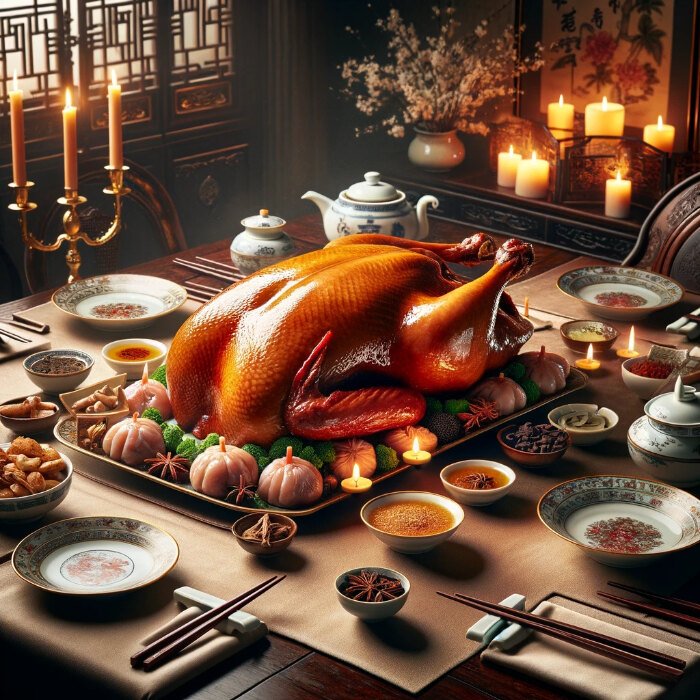
History and Origins of Peking Duck
Peking Duck, a beloved dish enjoyed by many, has a rich history that traces its roots back to the imperial era of China. Let’s delve into the fascinating origins of this delectable culinary delight.
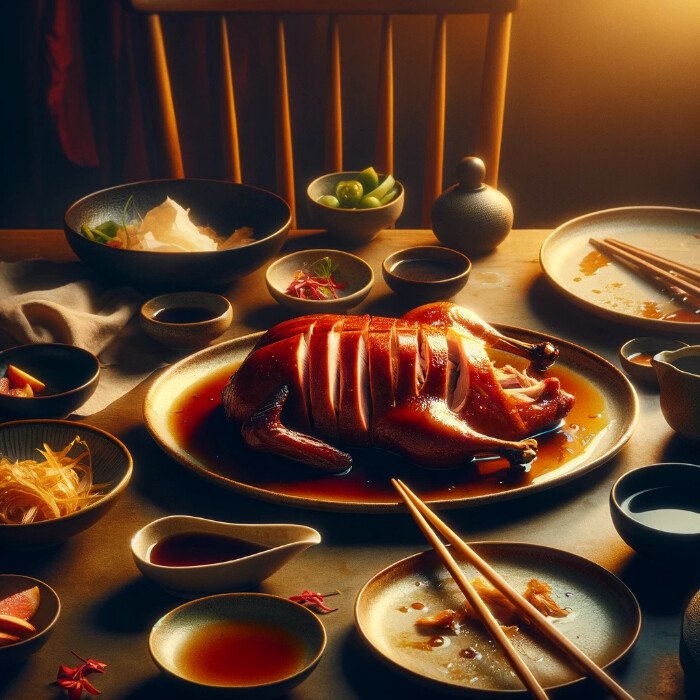
Traces its roots back to the imperial era of China
Peking Duck first made its appearance in cookbooks from the Yuan Dynasty (1271-1368). These ancient texts mention a recipe called “Shaoyazi,” which involved roasting ducks over an open fire. The dish is made by roasting the ducks until they are cooked to perfection. This early form of Peking Duck laid the foundation for what would become a culinary sensation.
First mentioned in cookbooks from the Yuan Dynasty (1271-1368)
During the Ming Dynasty (1368-1644), Peking Duck gained popularity among the upper classes. It was during this time that it acquired its name “Peking Duck.” The dish became highly regarded and was even served at royal banquets. The method of preparation evolved, with an emphasis on achieving crispy skin while retaining succulent meat.
Became popular during the Ming Dynasty (1368-1644)
The fame of Peking Duck continued to spread throughout China during subsequent dynasties. However, it wasn’t until the Qing Dynasty (1644-1912) that it truly reached new heights. The dish became synonymous with Beijing cuisine and attracted attention from foreign visitors who marveled at its unique flavors and presentation.
Today, Peking Duck remains one of China’s most iconic dishes, celebrated for its crispy skin, tender meat, and exquisite taste. It has also gained international acclaim, captivating taste buds around the world.
Traditional Recipe for Homemade Peking Duck
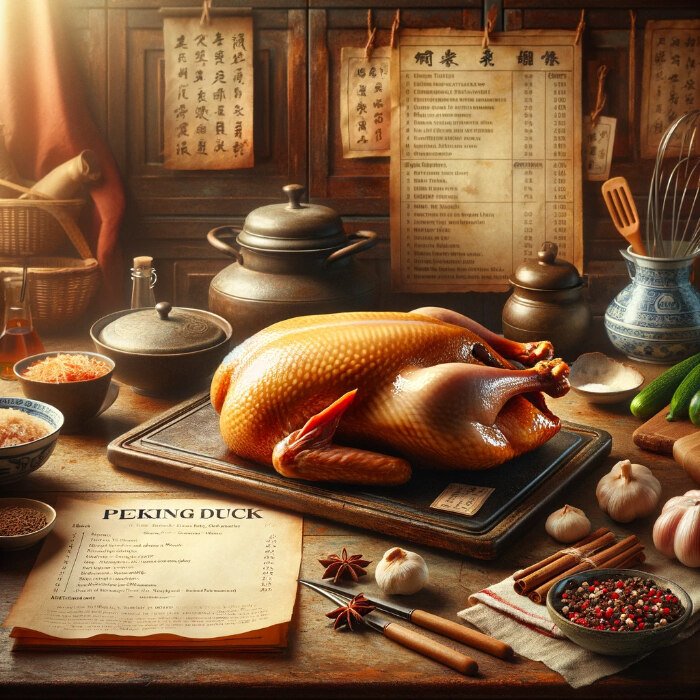
Marinating the Duck
To make your own homemade Peking duck, start by marinating the duck with a mixture of spices and soy sauce. This step is crucial as it infuses the duck with rich flavors. You can use a combination of ingredients like ginger, garlic, five-spice powder, Shaoxing wine, and hoisin sauce to create a tasty marinade. Allow the duck to soak in this mixture for at least 24 hours to ensure maximum flavor absorption.
Air-Drying the Duck
After marinating, it’s time to air-dry the duck before cooking it. This process helps achieve that signature crispy skin texture. Hang the duck in a cool and well-ventilated area for around 24-48 hours or until the skin becomes dry and tight. Some people prefer using a fan to expedite the drying process.
Roasting or Hanging Over Fire
Once the duck is properly dried, you have two options for cooking: roasting in an oven or hanging over a fire. If using an oven, preheat it to a high temperature (around 425°F/220°C) and place the duck on a rack positioned over a baking tray. Roast for about 20 minutes on each side until golden brown and crispy.
Alternatively, you can opt for traditional hanging methods where the duck is hung over an open fire or charcoal pit. This method imparts a smoky flavor while ensuring even cooking throughout.
The Cooking Process
Regardless of your chosen cooking method, be prepared for several hours of patience as Peking duck requires slow cooking to achieve perfection. It’s essential to monitor the doneness of both skin and meat during this process.
Once cooked, allow the duck to rest for a few minutes before carving into thin slices. These succulent slices are traditionally served with Mandarin pancakes (thin flour-based wrappers), scallions, cucumber, and hoisin sauce. Simply wrap the duck slices in a pancake with your desired accompaniments and enjoy the burst of flavors.
Step-by-Step Instructions for Making Peking Duck at Home
Start by cleaning and preparing the duck.
To begin making Peking Duck at home, you need to clean and prepare the duck. This involves removing any excess fat or feathers from the bird. Make sure to rinse it thoroughly with water and pat it dry using paper towels.
Apply a marinade to enhance flavor.
Next, it’s time to apply a flavorful marinade to the duck. You can create your own marinade using ingredients like soy sauce, hoisin sauce, honey, garlic, ginger, and Chinese five-spice powder. Mix these ingredients together in a bowl and then rub the marinade all over the duck, ensuring that it covers every part of the bird.
Roast the duck until it turns golden brown.
Once you have marinated the duck, it’s time to roast it in the oven. Preheat your oven to a high temperature (around 425°F or 220°C). Place the duck on a roasting rack inside a baking dish and cook it for about 15 minutes. Then reduce the heat to around 350°F (175°C) and continue roasting for another hour or so until the skin turns golden brown and crispy.
Carve and serve with traditional accompaniments.
After roasting, let the duck rest for a few minutes before carving it into thin slices. The traditional way of serving Peking Duck is by wrapping each slice in a thin pancake along with some spring onions, cucumber strips, and hoisin sauce. This combination creates an explosion of flavors in your mouth!
Making Peking Duck at home may require some time and effort but trust me; it’s worth every bit of work! With these step-by-step instructions, you’ll be able to recreate this famous Chinese dish right in your own kitchen.
Achieving Crispy and Tight Duck Skin
To achieve that perfect crispy and tight skin on your Peking duck, there are a few key steps you should follow. Let’s dive right in!
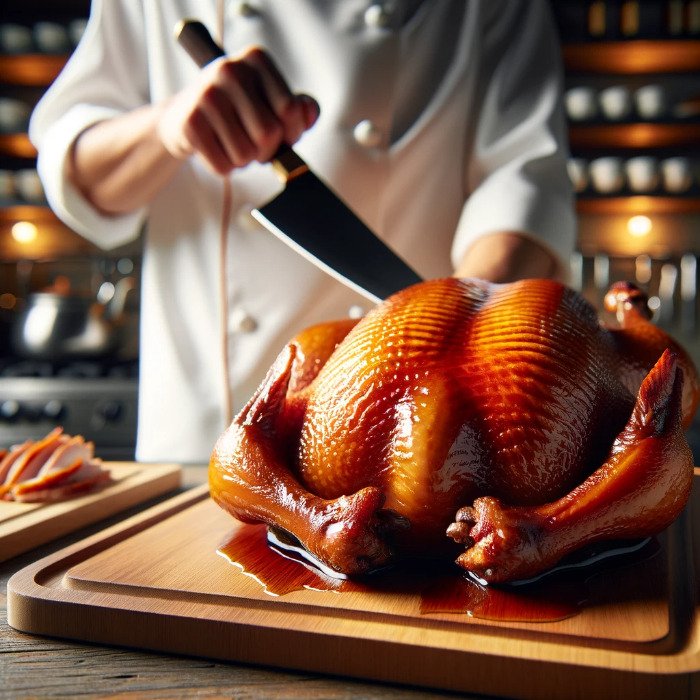
Pricking Holes in the Skin
Pricking holes in the duck’s skin is crucial for achieving that desired crispiness. These little punctures help release excess fat during cooking, resulting in a beautifully crispy skin. So grab a sharp fork or skewer and gently prick the skin all over before proceeding with the next steps.
Air-Drying Overnight
After pricking the skin, it’s time to air-dry the duck overnight. This step helps remove moisture from the skin, which is essential for achieving tightness when roasted. Place the duck on a wire rack set over a baking sheet and leave it uncovered in the refrigerator overnight. The dry air will work its magic, giving you that perfect texture.
Basting with Hot Oil
While roasting your Peking duck, basting it with hot oil is essential for promoting even browning and enhancing flavor. As the duck cooks, carefully brush hot oil over its surface at regular intervals. This process not only adds extra flavor but also contributes to achieving that golden brown color we all love.
By following these steps – pricking holes in the skin, air-drying overnight, and basting with hot oil – you’ll be well on your way to achieving that irresistible crispy and tight skin on your Peking duck.
Coating the Skin with Syrup for Extra Flavor
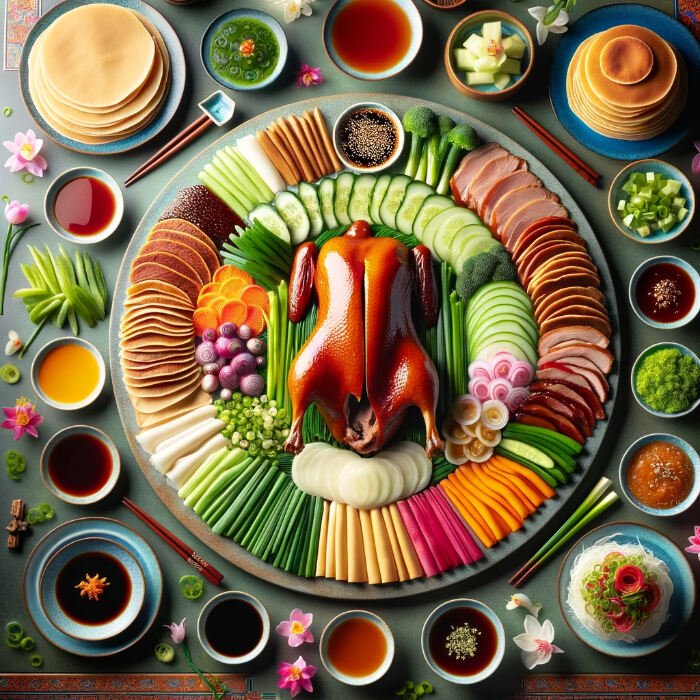
To take the flavor of Peking duck to the next level, it’s time to talk about coating the skin with syrup. After roasting the duck to perfection, a sweet and shiny glaze is created by brushing on a syrup made from maltose or honey. This step not only adds a touch of sweetness but also enhances both taste and presentation.
The syrup acts as a delicious sauce that covers the crispy skin, giving it an irresistible caramelized finish. As it caramelizes further under heat, it forms a beautiful glaze that makes your Peking duck look even more appetizing.
Coating the skin with syrup is relatively simple. Once your duck is perfectly roasted and you’ve removed any excess fat from the skin side, you can begin this final step. Here’s how:
1. Heat up some vinegar in a pan until it starts boiling.
2. Mix in maltose or honey (about 2-3 tablespoons) until fully dissolved.
3. Brush this mixture all over the duck’s skin using a pastry brush.
4. Make sure every inch of that crispy skin gets coated evenly.
5. Pop your glazed duck back into the oven for another couple of minutes to let it set.
Once done, you’re ready to serve your mouthwatering creation! Traditionally, Peking duck is enjoyed by wrapping slices of succulent meat and crispy skin in thin pancakes along with spring onions, cucumber strips, and hoisin sauce.
Coating the skin with syrup not only adds extra flavor but also gives your Peking duck that glossy appearance that will make everyone’s mouths water. So don’t skip this step if you want to elevate your culinary skills and impress your friends and family at your next dinner party!
Variations and Accompaniments for Peking Duck
Peking duck, a popular Chinese dish, is known for its crispy skin and succulent meat. While the duck itself takes center stage, there are various variations and accompaniments that enhance the overall dining experience.
Traditional Accompaniments
Thin pancakes are a must. These soft, delicate pancakes provide the perfect vessel for wrapping slices of tender duck meat. Alongside the pancakes, scallions and cucumber add freshness and crunch to each bite. And let’s not forget about the rich and savory hoisin sauce that brings all the flavors together.
Modern Variations
In recent years, chefs have been experimenting with new ways to enjoy Peking duck. One popular variation is serving it with steamed buns instead of pancakes. The pillowy texture of the buns complements the crispy skin and juicy meat beautifully. Some even go a step further by adding different fillings like pickled vegetables or chili sauce to create unique flavor combinations.
Beyond Wraps and Rolls
While Peking duck is most commonly enjoyed in wraps or rolls, its versatility extends beyond these traditional preparations. The succulent meat can be used in other dishes as well. For instance, it can be added to salads for an extra burst of flavor or incorporated into stir-fries for a satisfying meal.
The Essence of Peking Duck
Peking duck is a renowned dish that perfectly captures the essence of Chinese culinary heritage. With its crispy skin, tender meat, and rich flavor, each bite offers a delightful combination of textures and tastes. This authentic Beijing specialty reflects the craftsmanship and tradition that has been passed down through generations.
Crispy Skin, Tender Meat, Rich Flavor
One of the defining characteristics of Peking duck is its crispy skin. The skin is meticulously prepared through a process known as “lacquering,” where the duck is glazed with a mixture of maltose syrup or honey before being roasted to perfection. As a result, the skin becomes golden-brown and incredibly crispy.
Beneath the tantalizingly crisp skin lies succulent and tender meat. The ducks used for Peking duck are carefully selected for their size and breed to ensure optimal taste and texture. The meat is seasoned with aromatic spices such as star anise, cinnamon, and ginger before being roasted until it reaches a juicy tenderness.
The flavor profile of Peking duck is complex and deeply satisfying. The combination of savory umami notes from the meat, sweetness from the glaze, and subtle hints of spices create a harmonious taste experience that lingers on your palate.
A Culinary Heritage
Peking duck represents more than just a delicious meal; it embodies centuries-old culinary traditions originating from Beijing (formerly known as Peking). This dish has been enjoyed by emperors, nobles, and commoners alike throughout history.
The preparation process itself requires great skill and precision. From air-drying the whole duck to roasting it in special ovens designed to achieve even heat distribution, every step contributes to creating an exceptional dining experience.
Accompaniments That Complement
To enhance the flavors of Peking duck further, it is traditionally served with various accompaniments. Thin pancakes or steamed buns, known as “bao,” are used to wrap slices of the succulent duck meat. These wraps are typically garnished with hoisin sauce, cucumber strips, and spring onions, adding layers of texture and taste.
The contrast between the richness of the duck meat and the freshness of the vegetables creates a harmonious balance that elevates each bite. The combination of flavors and textures is what makes Peking duck such a beloved dish worldwide.
Conclusion
Now that you possess the knowledge to create mouthwatering Peking Duck, it’s time to gather your ingredients, roll up your sleeves, and embark on your culinary adventure. Invite friends and family over for a memorable feast or surprise them with a special homemade treat. The beauty of Peking Duck lies not only in its delicious flavors but also in the joy it brings when shared with loved ones. So go ahead, unleash your inner chef, and let the aroma of roasting duck fill your kitchen as you create an unforgettable dining experience.
FAQs
Can I use a regular oven instead of a specialized duck oven?
Yes, absolutely! While specialized duck ovens can provide optimal results, a regular oven can still produce excellent Peking Duck. Just make sure to follow the temperature adjustments mentioned in the recipe instructions for best results.
Can I substitute duck with another type of poultry?
While traditionally made with duck, Peking Duck recipes can be adapted to other types of poultry such as chicken or turkey. However, keep in mind that the flavor profile will differ slightly from the authentic version.
How long does it take to roast a whole duck?
The cooking time may vary depending on the size of the duck and individual oven settings. As a general guideline, roasting a whole duck usually takes around 2-3 hours. It’s important to monitor the internal temperature and ensure that the duck is cooked thoroughly.
Can I make Peking Duck ahead of time?
While it’s best to enjoy Peking Duck fresh out of the oven, you can partially prepare it in advance by marinating the duck and completing some initial steps. However, for the best texture and flavor, it’s recommended to roast the duck just before serving.
What are some common side dishes to serve with Peking Duck?
Traditional accompaniments for Peking Duck include thin pancakes or steamed buns, along with scallions, cucumber slices, and hoisin sauce. You can also pair it with stir-fried vegetables or a refreshing salad for a well-rounded meal experience.
Frequently Linked Pages
1. Chinese Food – Chinese Food: A Gastronomic Adventure into Authentic Oriental Flavors
2. Peking Duck Near Me – Peking Duck Near Me: Indulge in the Crispy Perfection of Authentic Chinese Cuisine
3. Dumplings Near Me – Dumplings Near Me: Best Deals & Delivery Options
4. Chop Suey – Chop Suey: A Delicious Culinary Adventure In Every Bite
5. Mapo Tofu – Mapo Tofu Recipe: The Authentic and Delicious Way!
6. Kung Pao Chicken – Kung Pao Chicken Recipe: Spicy Delight!
7. Wonton – Wonton Making: The Ultimate Guide
8. Chow Mein – Chow Mein: A Flavorful Exploration of the Classic Chinese Stir-Fried Noodles
9. Sashimi – sashimi: A Guide To The Delicate Art Of Raw Seafood




